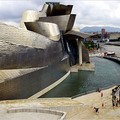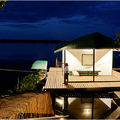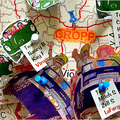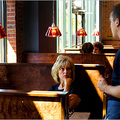IN October of 1852, a French clergyman saddles up a fine cream-colored mule and rides south out of Santa Fe. As the new Catholic bishop of the territory of New Mexico, he is embarking on his first visit to Indian pueblos.
“His great diocese was still an unimaginable mystery to him,” wrote Willa Cather in her novel “Death Comes for the Archbishop.” “He was eager to be abroad in it, to know his people.”
Isleta Pueblo, 13 miles south of Albuquerque, looks almost familiar to the bishop, with its startlingly white church, its clustered town and its acacia trees of the same blue-green color he knew in the south of France.
The scenery turns strange, though, as he rides west with his young Indian guide to Laguna Pueblo, and he begins not to believe his own eyes. Clumps of wild pumpkin look “less like a plant than like a great colony of gray-green lizards, moving and suddenly arrested by fear.” What seems at first to be bright waves of sand turn out to be petrified rock, “yellow as ochre” and dotted with ancient juniper trees.
By the time the travelers approach Ácoma, the third pueblo, they are passing colossal rock mesas, jutting upward 700 feet from the sandy plain. These formations look so bizarre to the bishop as to seem not part of nature at all, but rather like “vast cathedrals” or the remnants of a monumental city.
Today, these three pueblos are connected by freeways. Isleta and Ácoma have their own casinos. But each community still preserves its ancient identity. Eighty years after Cather's novel was published and more than 150 since the events she recounted, it is possible to use her narration as a visitor's guide. One warm March day, paperback in hand, I found my way to all three pueblos, grateful for Cather's sensitivity to the great beauty and mystery of the Southwest and for her ability to bring to life the characters who had encountered one another in the same landscape so long ago.
Cather's portrayal of Jean Marie Latour (her fictional name for the real-life bishop, John Baptist Lamy) paints a complicated but very romantic picture of New Mexico in the mid-19th century, just after its annexation to the United States. Despite its fictional embellishments, her book provides a realistic account of the bishop's efforts to replace the lawless and profligate Spanish priests of the territory, his visits to a beloved Navajo chief, his friendship with the Old West explorer Kit Carson and his dream of building a cathedral in Santa Fe.
But it is the trip to the pueblos that reveals the most about the bishop's predicament in the new country, because it imagines how he felt as he first entered the strange world of the Pueblo Indians. In Cather's telling: “When he approached the pueblo of Isleta, gleaming white across a low plain of gray sand, Father Latour's spirits rose. It was beautiful, that warm, rich whiteness of the church and the clustered town. The church and the Isleta houses were made of adobe, whitewashed with a bright gypsum.”
Today the pueblo houses are earth-colored, but the church is still pure white, its surface still regularly refinished. With its plain walls and heavy iron bells, it is an archetype of humble Southwestern style.
The church would have looked a little different in the bishop's day, and even then not as it did when it was first built in 1613. The roof and choir loft of the original building — a simple, long, high-ceilinged sanctuary — were destroyed in 1680, when the Pueblo Indians rebelled against the Franciscan missionaries. Rebuilt on the same walls in 1716, the church was given two wooden bell towers, now gone, which the bishop would have seen.
Leaving Isleta, Father Latour and his guide, Jacinto, ride through a sandstorm on their way to Laguna Pueblo, passing by the lake for which the village was named. That lake is dry now. But the 300-year-old mission church of St. Joseph remains precisely as Cather described it: “painted above and about the altar with gods of wind and rain and thunder, sun and moon, linked together in a geometrical design of crimson and blue and dark green, so that the end of the church seemed to be hung with tapestry.”
The bishop says Mass at St. Joseph's, but retires with Jacinto to the rocks north of the village to camp for the night. As the sun sets, the two men have the briefest of conversations about the stars and then lapse into their accustomed silence, contemplating the night sky.
“There was no way in which he could transfer his own memories of European civilization into the Indian mind,” Cather wrote of the bishop, “and he was quite willing to believe that behind Jacinto there was a long tradition, a story of experience, which no language could translate to him.”
The two continue their ride west, across the low plain among the great mesas, and the bishop is struck with the way each of the rock towers seems to be “duplicated by a cloud mesa, like a reflection, which lay motionless above it or moved slowly up from behind it.”
On the freshly paved highway through the same territory, just before reaching Ácoma, I passed another mesa that once had been inhabited, but was a ghost town even by the time the bishop rode by. As Jacinto explains in the novel, “the stairway which had been the only access to it was broken off by a great storm many centuries ago, and its people had perished up there from hunger.”
How, the bishop asks, did the people come up with the idea of living hundreds of feet in the air on naked rocks with no soil or water?
“A man can do whole lot when they hunt him day and night like an animal,” Jacinto says. “Navajos on the north, Apaches on the south; the Ácoma run up a rock to be safe.”
Ácoma is no longer the community it once was either. Ácoma families keep houses there as weekend and vacation homes. But the tribe has decided not to outfit the mesa top with electricity or running water, and it now lives mainly in a village on the valley floor. To reach the top now requires signing up for a guided tour, and taking a bus ride up.
For the bishop and Jacinto, a rugged rock stairway with primitive steps and handholds is the only route. When he reaches the top, the bishop is amazed at the white two- and three-story dwellings clustered together on the 10-acre pueblo, with “not a tree or blade of green upon it.” And he is alarmed at the sight of the mission church.
“Gaunt, grim, gray, its nave rising some 70 feet to a sagging, half-ruined roof, it was more like a fortress than a place of worship,” Cather wrote.
The bishop wonders why such a big church had even been built there in the early 1600s: “Powerful men they must have been, those Spanish Fathers, to draft Indian labor for this great work without military support.”
The priests forced the Indians to carry up not only building materials for the church but great quantities of earth for the churchyard cemetery.
“Every stone in that structure,” the bishop mused, “every handful of earth in those many thousand pounds of adobe, was carried up the trail on the backs of men and boys and women. And the great carved beams of the roof — Father Latour looked at them with amazement. In all the plain through which he had come he had seen no trees but a few stunted piñons. He asked Jacinto where these huge timbers could have been found.
“ ‘San Mateo mountain, I guess.'
“ ‘But the San Mateo mountains must be 40 or 50 miles away. How could they bring such timbers?'
“Jacinto shrugged. ‘Ácomas carry.' Certainly there was no other explanation.”
The Ácoma woman who guided my tour seemed to regard the building of the church with the same outrage. The Indians resented the missionaries' demands on their ancestors to such a degree, she remarked, that the Ácoma today speak only English and their native language, but never Spanish.
The Indians clung to their ancient religion even as they genuinely cooperated in the Catholic rituals. The practices still go on side by side. A short walk from the mission church is the pueblo's sacred kiva, its white-painted outdoor ladders angled northward, toward the place from which the ancestors came.
When the bishop says Mass in the church, he finds it difficult to go through the ceremony. “Before him, on the gray floor, in the gray light, a group of bright shawls and blankets, some 50 or 60 silent faces; above and behind them the gray walls. He felt as if he were celebrating Mass at the bottom of the sea, for antediluvian creatures; for types of life so old, so hardened, so shut within their shells, that the sacrifice on Calvary could hardly reach back so far. ...When he blessed them and sent them away, it was with a sense of inadequacy and spiritual defeat.”
Father Latour waits until the next day to descend. That night, he sleeps in the loggia in the corner of the priest's cloister. “He was on a naked rock in the desert, in the stone age, a prey to homesickness for his own kind, his own epoch,” Cather wrote, “for European man and his glorious history of desire and dreams.”
VISITOR INFORMATION
HOW TO GET THERE
Isleta Pueblo is a 15-minute drive south of Albuquerque on Interstate 25. Laguna is a half-hour drive west of Albuquerque off Interstate 40 (exit 114), and Ácoma is 20 to 25 minutes farther west from Laguna. To reach Ácoma, take exit 102, turn south and drive through mesa country for 11 miles. Park at the visitors center.
WHERE TO STAY
The pueblos are close enough to Albuquerque that it is convenient to stay in hotels there. But the Sky City Casino Hotel in Ácoma, 11 miles north of the old mesa-top pueblo, has modern, clean and comfortable rooms for $89 a night (888-759-2489; www.skycity.com).
To get a flavor of the bishop's favored New Mexico landscape, stay on the grounds of his old getaway. The sprawling Bishop's Lodge (505-983-6377; www.bishopslodge.com), three miles north of downtown Santa Fe, has preserved the simple little white wood-and-stone chapel and rooms where Bishop John Baptist Lamy planted orchards and spent his retirement. Today, the 450-acre resort offers horseback riding, pool swimming, tennis, extensive walking trails and, in the spa, massage therapy. Rooms range from $200 to $1,500.
WHAT TO SEE
St. Augustine Church (505-869-3398) at Isleta Pueblo and the San Jose Mission Church (505-552-9330) in Laguna are both open to the public. (No charge but donations are accepted.) The only way to see the old Ácoma mesa-top pueblo and its mission church of St. Stephen is to take a guided tour (800-747-0181; www.skycity.com). Buses drive visitors to the top of the mesa, and the tour of the church, cemetery and surrounding homes and cisterns takes about an hour. The cost is $12 for adults, $11 for seniors and $9 for children. A $10 permit is required to carry a camera.
The Cathedral Basilica of St. Francis of Assisi (505-982-5619) in Santa Fe, whose construction was planned and overseen by Bishop Lamy, is a block east of Santa Fe Plaza and open to the public.
WHERE TO SHOP
The best place to buy Ácoma pottery, distinguished by pale pink clay and delicate designs, is on the mesa top. Individual artists sell directly to visitors from tables on the tour path.
In Isleta, Pueblo Indian pottery and other arts and crafts are on sale at Josephine Padilla's Hummingbird Gift Shop (505-869-3941), a short stroll from the mission church.







